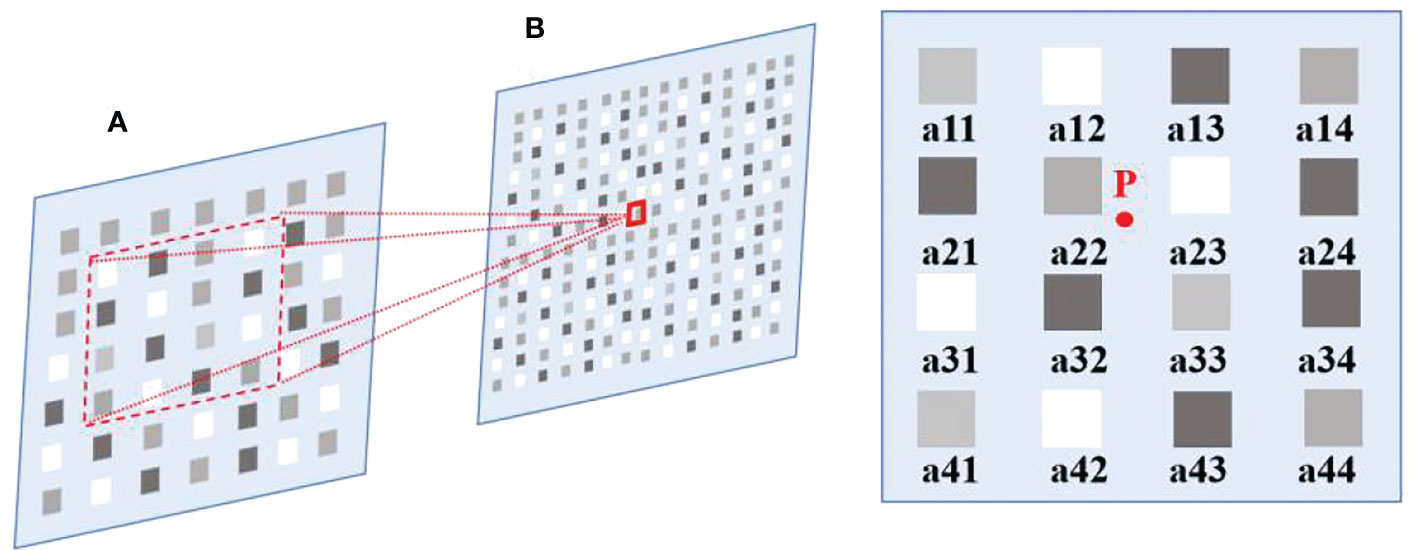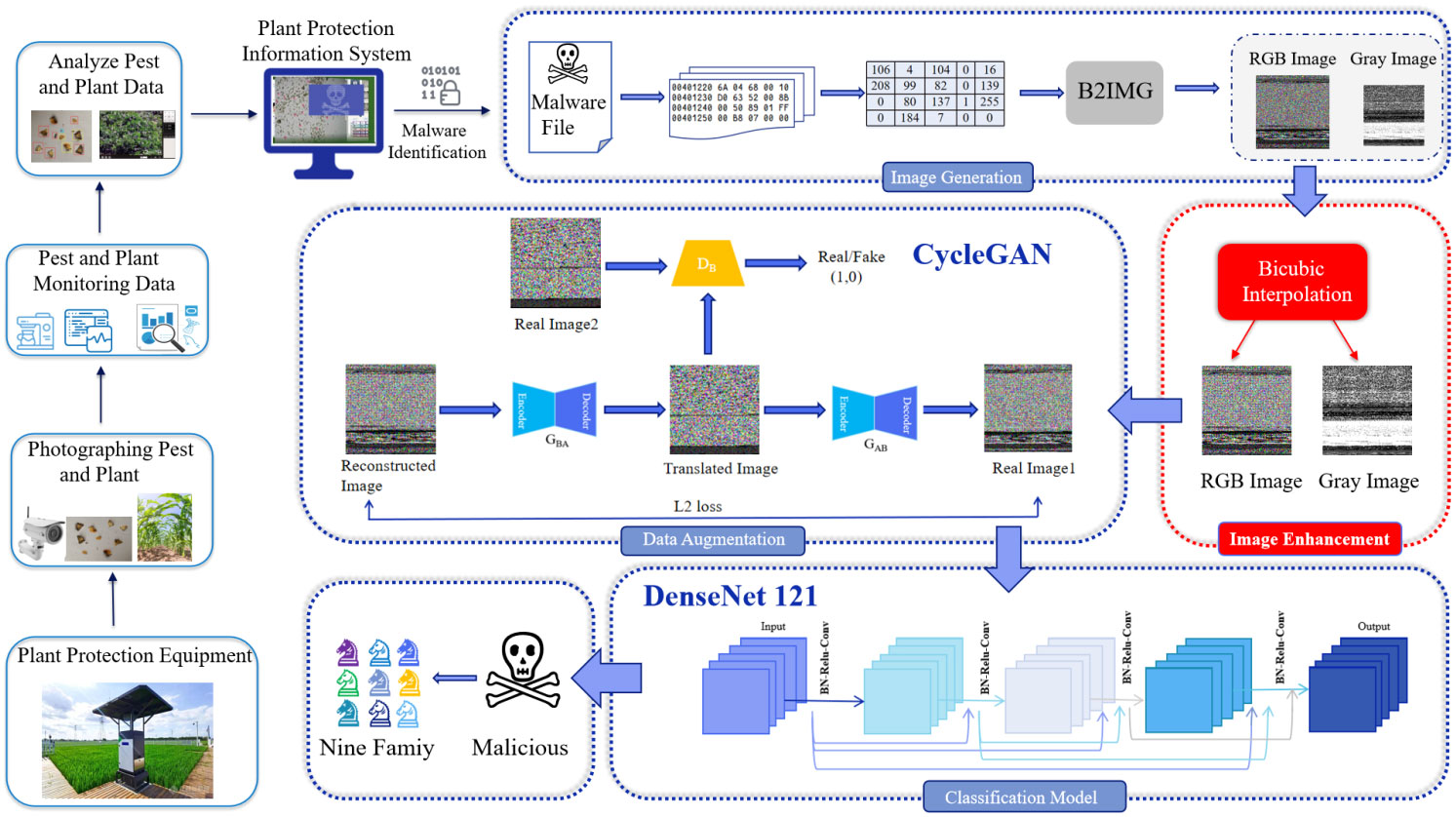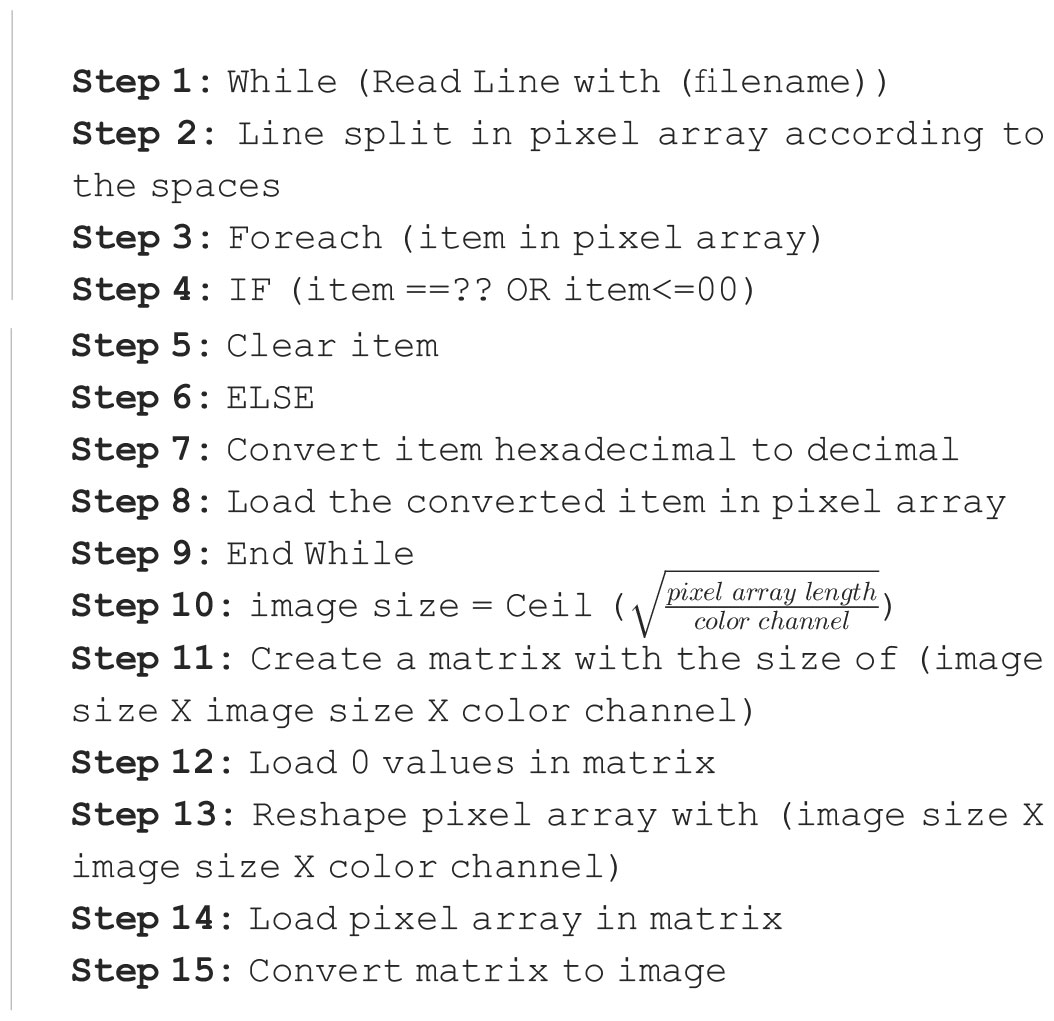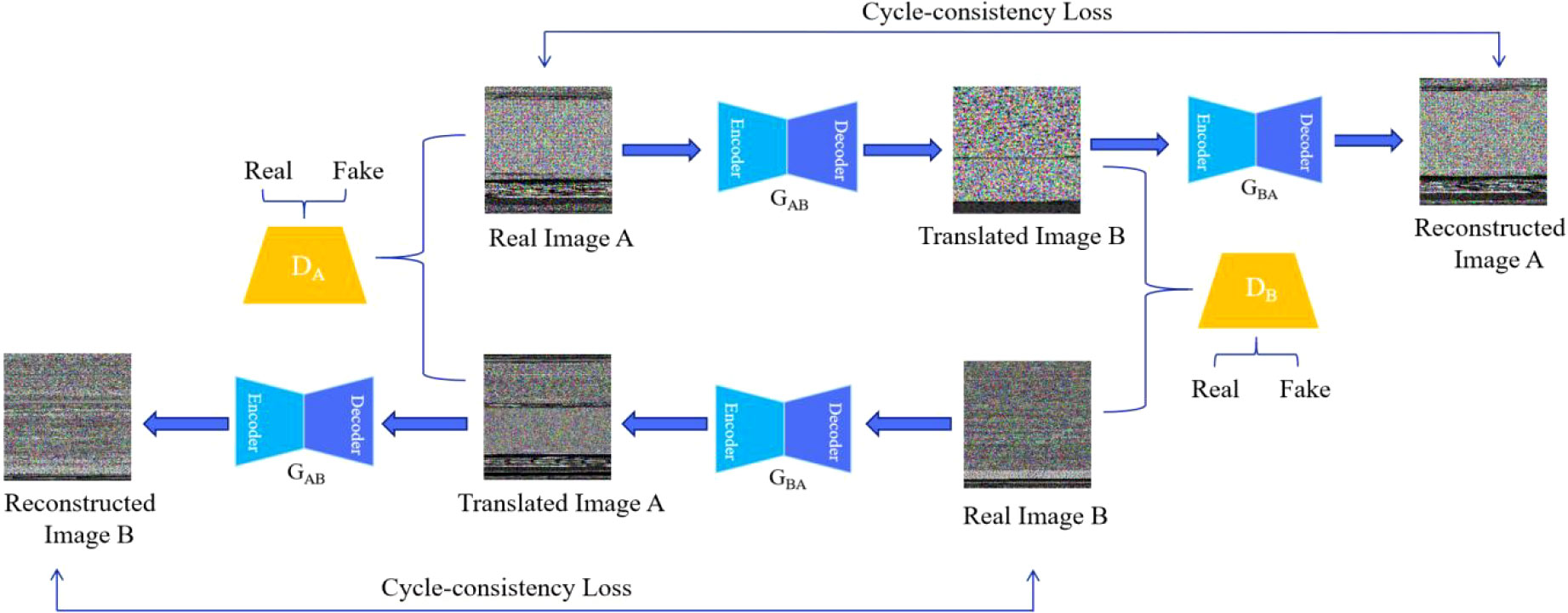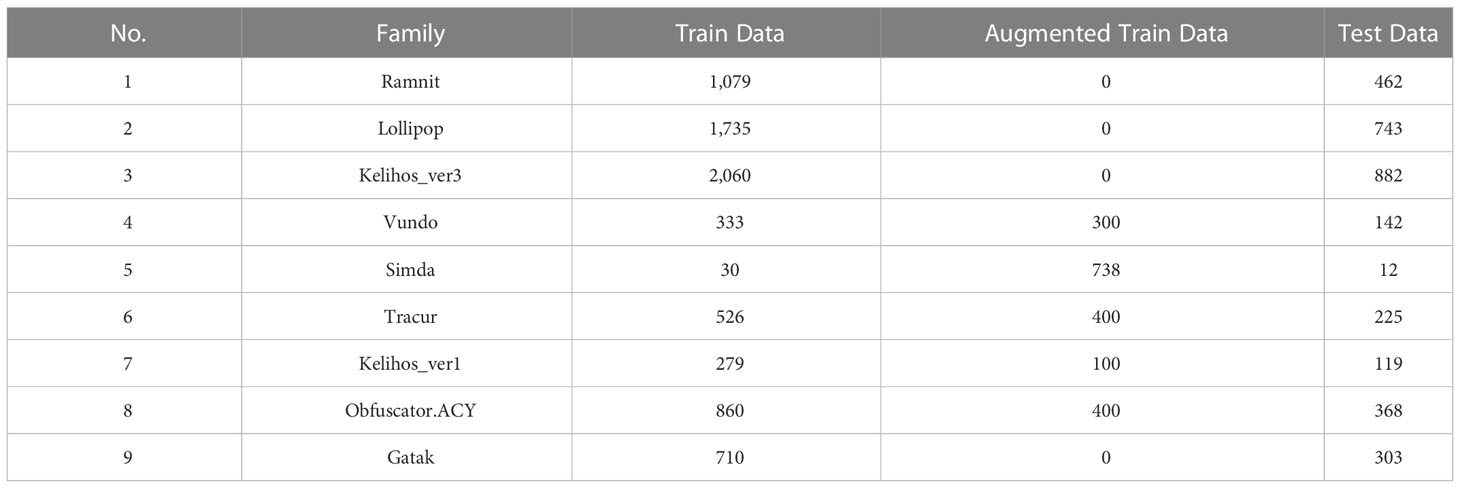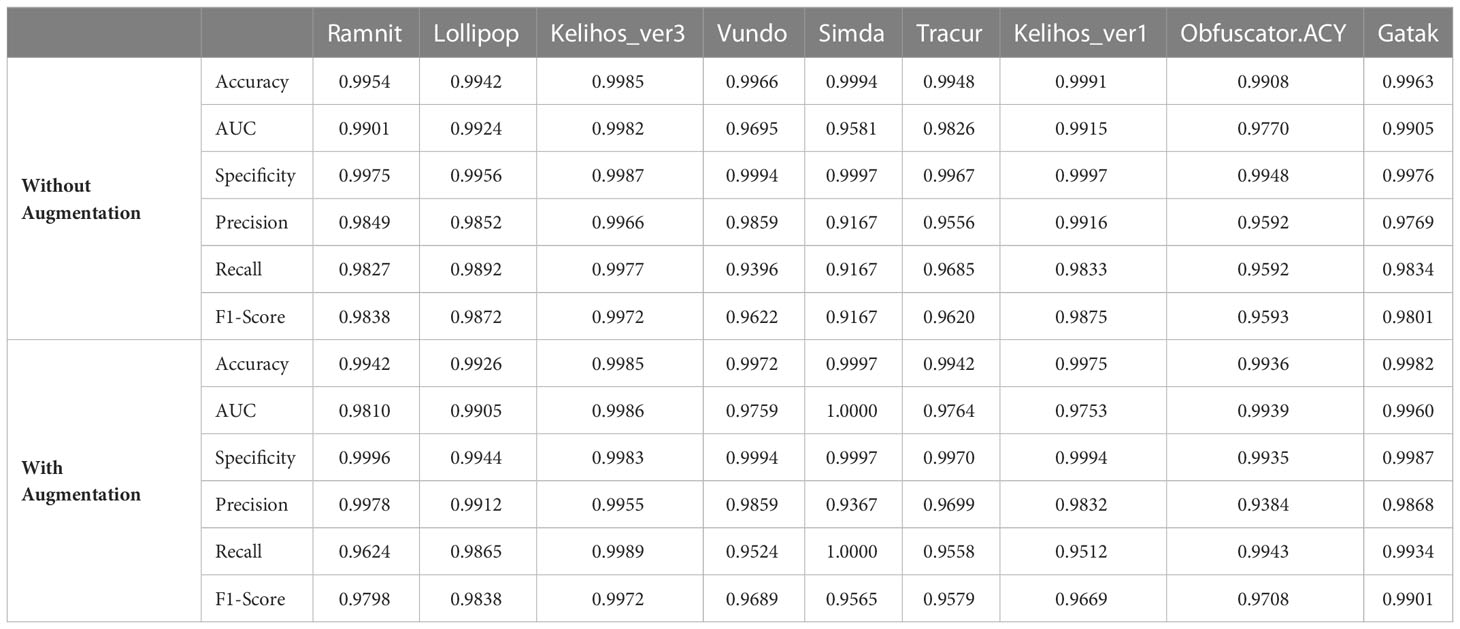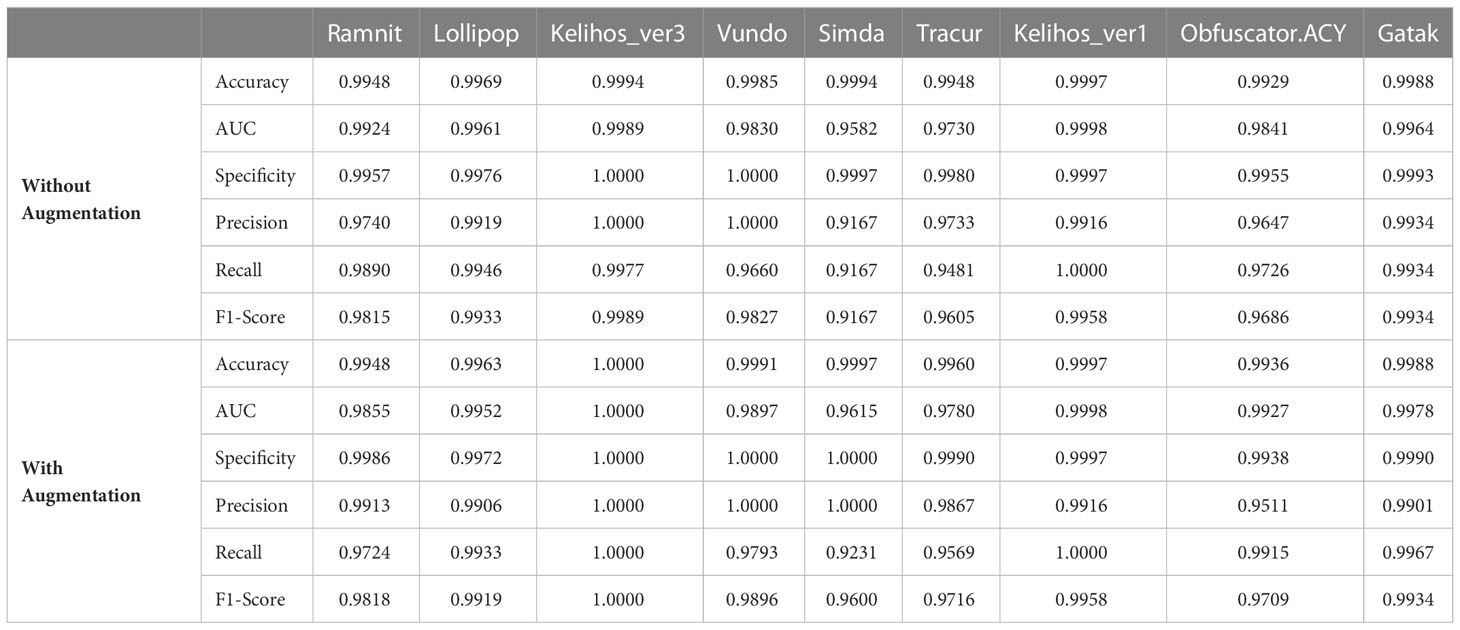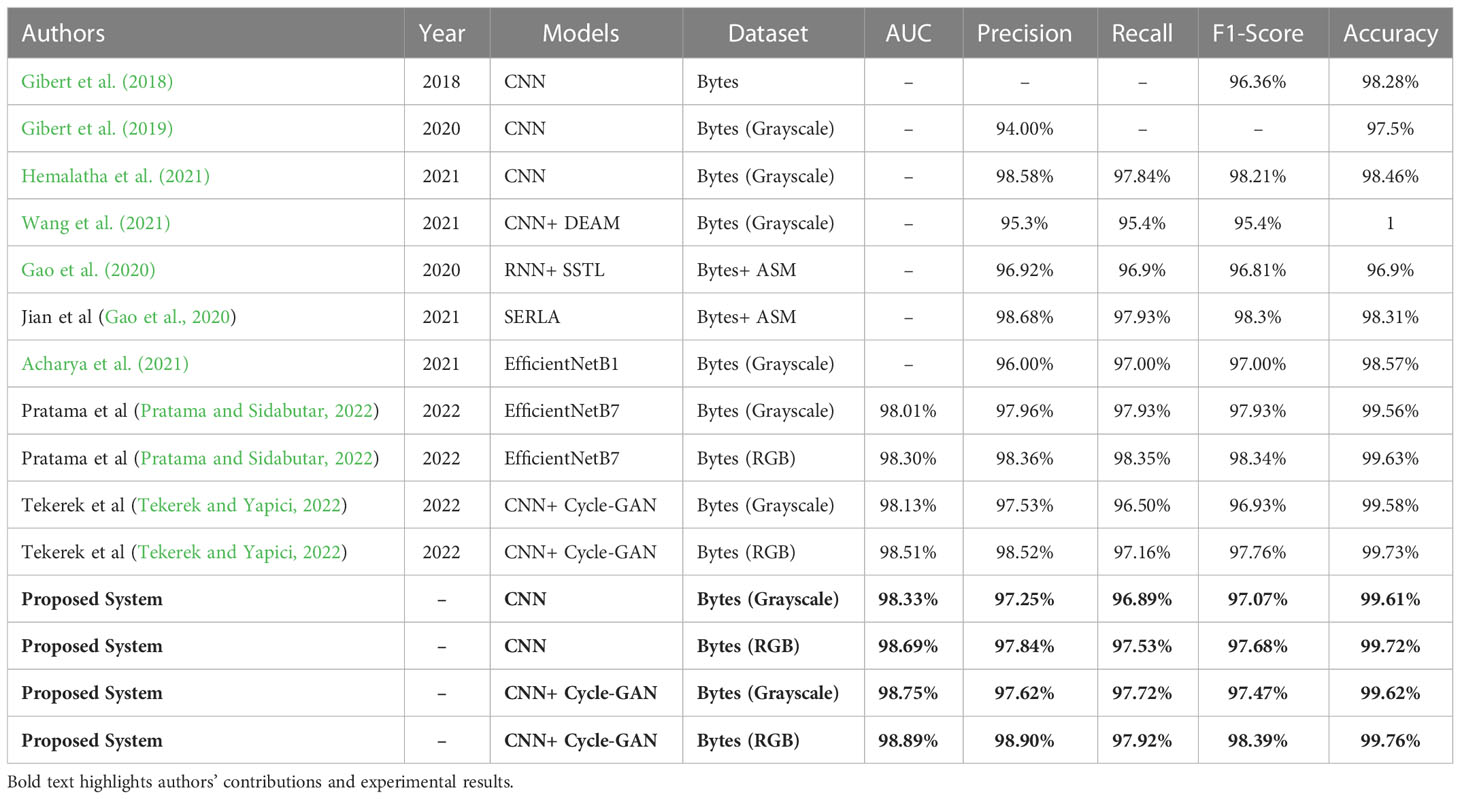- 1Engineering Research Center of Digital Forensics, Ministry of Education, Nanjing University of Information Science and Technology, Nanjing, China
- 2School of Computer and Software, Nanjing University of Information Science and Technology, Nanjing, China
Due to developments in science and technology, the field of plant protection and the information industry have become increasingly integrated, which has resulted in the creation of plant protection information systems. Plant protection information systems have modernized how pest levels are monitored and improved overall control capabilities. They also provide data to support crop pest monitoring and early warnings and promote the sustainable development of plant protection networks, visualization, and digitization. However, cybercriminals use technologies such as code reuse and automation to generate malware variants, resulting in continuous attacks on plant protection information terminals. Therefore, effective identification of rapidly growing malware and its variants has become critical. Recent studies have shown that malware and its variants can be effectively identified and classified using convolutional neural networks (CNNs) to analyze the similarity between malware binary images. However, the malware images generated by such schemes have the problem of image size imbalance, which affects the accuracy of malware classification. In order to solve the above problems, this paper proposes a malware identification and classification scheme based on bicubic interpolation to improve the security of a plant protection information terminal system. We used the bicubic interpolation algorithm to reconstruct the generated malware images to solve the problem of image size imbalance. We used the Cycle-GAN model for data augmentation to balance the number of samples among malware families and build an efficient malware classification model based on CNNs to improve the malware identification and classification performance of the system. Experimental results show that the system can significantly improve malware classification efficiency. The accuracy of RGB and gray images generated by the Microsoft Malware Classification Challenge Dataset (BIG2015) can reach 99.76% and 99.62%, respectively.
1 Introduction
Due to increasing levels of industrialization and urbanization, dozens of major diseases and pests found on 2 billion hectares of land around the world all year round (Sun et al., 2019). The management of these diseases and pests requires a significant amount of manual input for agricultural plant protection operations, resulting in a sharp rise in labor costs (Yongliang et al., 2019; Brown et al., 2022). Therefore, intelligent plant protection information systems such as rice canopy pest monitoring systems (Li et al., 2022), field pest monitoring and forecasting systems (Liu et al., 2022), meteorological monitoring systems, and crop disease real-time monitoring and early warning systems have been widely used. The visualization and digitization of pest information improve the efficiency of pest forecasting and reduces the amount of work for plant protection staff at the grassroots level. Users can view data in real-time and manage equipment remotely through a cloud platform or mobile application to realize information management, so as to complete wireless transmission, transportation control, and information data sharing among information collection stations at all levels. However, agricultural-related data storage terminals face increasingly complex agricultural and network security situations, are threatened by various malicious software, and bear security risks such as data leakage, data theft, data loss, and data trafficking. Therefore, security systems must respond quickly to malware using new attack techniques, protect terminals from attacks, maintain the security and integrity of plant protection data, and protect the interests of farmers and the benefits of agricultural production. This paper aims to find an effective method to accurately classify malware and its variants into their families, so as to improve the malware identification and classification efficiency and enhance the comprehensive security protection capabilities of terminal systems in the construction of plant protection informatization. Many companies and scholars have proposed various malware classification techniques, which are mainly divided into two categories: signature-based classification and anomaly-based classification (Gandotra et al., 2014). Most commercial antivirus products use a signature-based approach to determine whether the software is malicious by scanning and matching signatures of known malware. This approach can quickly identify existing malware in a malware library with a low error rate but cannot identify unknown malware. Due to developments in computing power and artificial intelligence, the anomaly-based method has attracted much attention. Researchers have proposed many malware classification schemes based on this technique, which effectively overcome the limitations of signature-based methods. Malware classification schemes based on the anomaly method mainly extract features through static and dynamic analysis and selects a classification algorithm to build a model.
Dynamic analysis is the observation of the real behavior of a program at runtime which is achieved by monitoring the program’s execution in a sandbox or a virtual machine (Galal et al., 2016; Jamalpur et al., 2018). During monitoring, actions performed by programs (such as library usage, API calls (Salehi et al., 2017), network traffic, etc.) are recorded as reports. Researchers analyze characteristics in the reports to effectively categorize malware. Dynamic analysis methods attempt to discover all the actual operations of a program based on its behavior. Therefore, unknown and variant malware samples can be identified to improve the efficiency of malware classification (Ghiasi et al., 2015). However, dynamic analysis has certain limitations, such as possible infection of terminal systems, lack of suitability for real-time classification, and compromised monitoring due to evasion techniques.
Static analysis is a method of identifying and classifying executable programs without running them. It scrutinizes the “genes” of a file, rather than the current behavior which can be changed or delayed to an unexpected time in order to evade the dynamic analysis (Nissim et al., 2014). Static analysis has been proposed that mostly used by anti-malware products for automatic malware analysis. This technique allows the study of different features to build a classification system that effectively distinguishes the families to which malware belongs, such as opcode instructions (Lu, 2019), binary (Lad and Adamuthe, 2020), API (D’Angelo et al., 2020), PE header information (Rezaei et al., 2021), etc. This method can classify unknown malware and its variants, and is easier to implement than dynamic analysis. However, static malware analysis suffers from low accuracy and a high false positive rate. To overcome these shortcomings, most existing systems combine a large number of different types of features (Kim et al., 2018). Using a large number of features will cause time consumption and memory overhead, and is not suitable for real-time classification.
In recent research, static analysis methods combining malware visualization and deep learning (Liao et al., 2021; Chen et al., 2023)effectively alleviated the pressure of feature engineering technology in processing a large number of features, reduce time overhead, and make up for the shortcomings of traditional static classification methods (Yuan et al., 2020), which has achieved success in the field of malware classification. These methods visualize the binary sequence of malware as gray, RGB, or other types of images as the input of the models and use deep learning algorithms to build effective classification models that are most conducive to distinguishing the families to which malware belongs (Pinhero et al., 2021). However, in the process of visualizing the binary sequence of malware into image representation, most researchers use the zero-filling method which generates images with redundant and irrelevant features (Tekerek and Yapici, 2022). This affects the accuracy of malware classification. The existing malware benchmark datasets have the problem of unbalanced malware family data. The researchers proposed using GAN network (Park et al., 2020; Wang et al., 2022) to expand the data of small class samples to improve the efficiency of malware identification and classification. In response to the above problems, this paper proposes a malware classification system based on bicubic interpolation, Cycle-GAN, and CNNs. The accuracy of the test on the BIG2015 dataset provided by Microsoft can reach 99.76%.
The main contributions of the paper are as follows:
(i)We performed image enhancement on images converted from byte files using bicubic interpolation to preserve the integrity of malware data, addressing malware image size imbalances and image conversion distortions.
(ii)We used Cycle-GAN to perform data augmentation on gray and RGB images transformed from the BIG2015 dataset, solving the data imbalance among malware families.
(iii)We used the optimized DenseNet model to build a system to improve the efficiency of malware classification and the security capabilities of plant protection information terminal systems.
This paper is organized as follows. Section 2 provides an overview of the related work. Section 3 presents the materials and methodology. Section 4 describes the proposed system based on deep learning. Section 5 presents the experimental results and analysis. Section 6 summarizes this paper and future work.
2 Related work
2.1 Malware identification based on deep learning
Deep learning techniques such as CNN and recurrent neural networks (RNNs) have been widely used in the field of malware identification. Kumar et al (Kumar, 2021) proposed a malware classification system based on a fine-tuned convolutional neural network (MCFT-CNN). Without prior knowledge of feature engineering, binary code analysis, reverse engineering, detection, and avoidance, the system can effectively identify unknown malware samples. The classification accuracy of MalImg and BIG2015 datasets reached 99.18% and 98.63%, and the prediction time was 5.14ms and 5.15ms, respectively. The experimental results demonstrated the high efficiency of the system in identifying unknown malware, and the results on different datasets verify the universality of the system. Vasan et al. (2020) proposed an image-based malware classification system that uses a CNN architecture (IMCEC) to identify packed and unpacked malware. The experimental results show that the classification accuracy of packaged and unpackaged malware on the MalImg dataset reaches 98% and 99%, respectively. Vasan et al. (2020) proposed a malware classification system based on deep learning. The proposed fine-tuned convolutional neural network architecture (IMCFN) can effectively detect hidden code, obfuscated malware, and its variants. Experimental results show that the classification accuracy of MalImg and IoT-android datasets can reach 98.82% and 97.35%, respectively. Wang et al. (2021) proposed a gray image-based malware detection and classification system consisting of a deep efficient attention module (DEAM) and a DenseNet module. A detection accuracy of 99.3% was achieved on a dataset constructed from 1,087 benign samples collected by the authors and 1,087 malware samples randomly selected from the MalImg and BIG2015 datasets. The classification accuracy of 98.5% and 97.3% on the MalImg and BIG2015 datasets also verifies that the system can significantly improve the efficiency of malware classification. Gilbert et al (Gibert et al., 2018) proposed a deep learning system based on entropy flow to classify malware. The system used the entropy signal of wavelet transform to describe the change of entropy energy and achieved the purpose of classification by mining the similarity between the malware’s entropy streams. Experimental results show that the classification accuracy of the BIG2015 dataset reached 98.28%. Gao et al. (2020) proposed a cloud-based semi-supervised transfer learning (SSTL) framework consisting of detection, prediction, and transfer components. Experimental results on the BIG2015 dataset show that semi-supervised transfer learning can improve the accuracy of detecting components from 94.72% to 96.9%. Hemalatha et al. (2021) proposed an efficient malware classification system based on deep learning methods. The system uses a high-weight class-balanced loss function in the final classification layer of the DenseNet model, which achieves remarkable results in malware classification by addressing the data imbalance problem. The classification accuracy of the system on the MalImg, BIG2015, MaleVis, and Malicia datasets reached 98.23%, 98.46%, 98.21%, and 89.48%, respectively.
Deep learning technology can achieve more flexible malware feature representation, abstract all kinds of information contained in malware images layer by layer, and help to develop automatic and general models for identifying and classifying malware. Therefore, this paper uses the DenseNet deep learning model to build a malware classification system to effectively identify and classify malware and its variants.
2.2 Malware identification based on visualization technology
In the field of malware identification, researchers use visualization technology to visualize malware samples as image representations and identify malware by analyzing the visual similarity between images. Jian et al (Gao et al., 2020). proposed a deep neural network-based malware classification system (SERLA). The system utilizes image visualization and data augmentation techniques to convert the BIG2015 dataset into three-channel RGB images as input to the SERLA system. The experimental results show that the classification accuracy of the SERLA system on the BIG2015 dataset is 98.13%. Gibert et al. (2019) proposed a malware classification system based on gray images and deep learning methods. The system can capture similar characteristics between malware variants and precisely classify them into families. Experimental results show that applying the CNN model to the BIG2015 dataset achieves a classification accuracy of 97.5% and an average classification time of 0.001s. Ni et al. (2018) proposed an efficient malware classification system based on the CNN model and SimHash. The authors converted the disassembly malware code from the BIG2015 dataset into SimHash-based gray images, extracted pixel features through the CNN model, and effectively identified the family of malware. The experimental results show that the classification accuracy of the system on the BIG2015 dataset can reach 99.26%. Kalash et al. (2018) proposed a gray image-based malware classification system. The authors converted malware binary files into gray images and efficiently classified them through a CNN model. The experimental results show that the classification accuracy of the system on the Malimg and BIG2015 datasets reaches 98.52% and 99.97%, respectively. Jang et al. (2020)proposed a fastText-based local feature visualization method. This method extracts local features such as opcodes and API function names from malware and selects important local features in each malware family for embedding and visualizing through a word frequency-inverse document frequency algorithm. The experimental results show that the classification accuracy of this method on the BIG2015 dataset is about 99.65%.
The malware classification method based on visualization technology does not require disassembly and a time-consuming feature extraction process and can capture the difference between malware and its variants, so as to effectively classify malware. Therefore, malware visualization methods are beneficial to improve classification efficiency while reducing system complexity. Moreover, the visualization method can be applied to large-scale malware classification tasks without employing feature engineering techniques. This paper leverages visualization techniques to convert the BIG2015 dataset into gray and RGB image representations for the efficient classification of malware families.
2.3 Malware identification based on GAN networks
Generative adversarial networks (GANs), which consist of generative networks and discriminative networks, can be used for image-to-image translation and to generate high-quality images. In the field of malware classification, researchers use GANs to augment the data of classes with a small number of samples, so as to solve the problem of unbalanced malware datasets and improve classification efficiency. Tekerek et al (Tekerek and Yapici, 2022). proposed a malware classification system composed of cycle-consistent generative adversarial networks (Cycle-GAN) and DenseNet121 models. The byte files of the BIG2015 dataset were converted into gray and RGB images by B2IMG, the Cycle-GAN model was used to expand the data of the small sample family, and the DenseNet121 model was used to effectively classify the malware. The experimental results show that a classification accuracy of 99.73% is achieved on RGB images converted from the BIG2015 dataset. Rigaki et al (Rigaki and Garcia, 2018) proposed a method of generating network traffic with GANs to simulate other types of traffic. The authors modified the source code of the malware by receiving parameters from the GAN to modify the behavior of its command-and-control (C2) channel, thereby simulating Facebook chat network traffic. Experimental results show that GAN provides effective sample data for malware classification while successfully modifying malware traffic. Won et al (Won et al., 2022) proposed a generative adversarial network-based malware simulation framework (PlausMal-GAN) to augment malware image data. Experimental results show that the framework is beneficial for identifying and predicting zero-day malware-like images. Gao et al. (2022) proposed an efficient classification framework (MaliCage) for packaged malware. Experimental results show that the MaliCage framework composed of a packer detector, malware classifier, and packer GAN can classify packed malware with an accuracy of 91.66%. Singh et al. (2019) proposed a GAN-based malware image generation model (MIGAN). Experimental results show that MIGAN can improve the performance of classifiers by performing data augmentation on malware images generated from binary files, intrusion detection, and log files.
The creation of data labels for the benchmark dataset requires manual marking and is time consuming, however, GANs can learn features from real data and generate similar data without data labels. GANs can be used to generate network traffic and simulate malware data to expand the dataset, thus effectively improving the identification and classification performance. Therefore, this paper uses the Cycle-GAN model to expand the image data to balance the number of samples.
3 Materials and methodology
3.1 Dataset
The Microsoft Malware Classification Challenge Dataset (BIG2015) (Ronen et al., 2018) is a benchmark dataset in the field of malware classification. The dataset contains more than 20,000 assembly and bytecode files composed of 9 different malware families:Ramnit, Lollipop, Kelihos_ver3, Vundo, Simda, Tracur, Kelihos_ver1, Obfuscator.ACY, and Gatak. The specific data distribution is shown in Table 1. Each byte file contains a hexadecimal representation of the file’s binary content, excluding headers. Each ASM file contains various metadata information extracted from the binary file, such as logs of function calls, strings, etc. This paper uses the byte files in this dataset for system verification and analysis.
3.2 Bicubic interpolation
Bicubic, Lanczos, and other bicubic interpolation algorithms have been successfully applied to data enhancement, digital splicing of multiple scenes, and information extraction (Rifman, 1973; Bernstein, 1976). Bicubic interpolation preserves the details of the original image as much as possible by interpolating or increasing the number/density of pixels in the image. In this algorithm, the value of the function f at the point (x, y) is obtained by calculating the weighted average of the nearest 16 sample points in the rectangular grid. The interpolation function in each direction is calculated using the formulas of Eq. (1) and Eq. (2).
Where x is the distance between the pixel point (x, y) and the last 16 sample points, α is usually 1 or 0.5.
For the interpolated pixel point (x, y) (x, y can be floating numbers), select a point near 4 × 4 and use Eq (2) to calculate the weighted sum.
As shown in Figure 1, suppose the size of the source image A is m × n, and the size of the scaled target image B is M × N. According to the ratio, the corresponding coordinates of B(X, Y) on A can be obtained from A(x, y) =A(X × (m/M), Y × (n/N)). of the target image. Point P is the coordinate at (X, Y) corresponding to the target image B on the source image A. Assume that the coordinates of P are P(x + u, y+v, where x, y represent the integer part, and u, v represent the fractional part. As shown in Figure 1, the position of the nearest 16 pixels is represented by α(i, j=1, 2, 3, 4). According to Eq. (1), the influence factor W on the pixel value of point P is used to obtain the pixel value of the corresponding point of the target image, so as to achieve the purpose of image scaling.
In the field of malware classification, bicubic interpolation can effectively balance image size and correct distorted images (Keys, 1981). Dai et al. (2018) proposed a gray image-based malware classification system. The authors used the bicubic interpolation algorithm to equalize the size of the gray image converted from the memory dump file and used the image features extracted from the gradient histogram as input for malware classification. Experimental results show that the system achieves a classification accuracy of 95.2% on the Open Malware Benchmark dataset. Cui et al. (2018)proposed a deep learning-based malware classification system. The author used a bicubic interpolation algorithm to equalize the size of gray images converted from malicious code and used a CNN model to classify malware images. Experimental results show that the accuracy of the system on the MalImg dataset can reach 94.5%.
In this paper, the bicubic interpolation algorithm is used to enhance the gray and RGB images generated by the BIG2015 dataset to overcome the problems of pixel distortion and image size imbalance in the image conversion process. Experimental results show that image enhancement is beneficial to remove redundant and irrelevant features and improve the accuracy of malware classification.
4 Proposed system
The plant protection information system is also threatened by malware when it is monitoring and defending against pests and diseases. In order to ensure the safe and stable operation of the plant protection information system, we proposed a static identification and classification system architecture of malware, as shown in Figure 2. The classification system utilizes bicubic interpolation, Cycle-GAN, and DenseNet121 to improve the efficiency of malware classification. The system mainly includes three parts: (1) Image generation and image enhancement, (2) Data augmentation, and (3) Classification model. Image Generation and Image Enhancement: The hexadecimal features of the byte files in the BIG2015 dataset are converted to decimal features between 0 and 255, and the malware is visualized as gray and RGB images. We use the bicubic interpolation algorithm to enhance the gray and RGB images to solve the problems of image distortion and size imbalance. Data augmentation: We use the Cycle-GAN model to perform data augmentation on a small number of samples in the BIG2015 dataset to address data imbalances among malware families. Classification model: We build an efficient malware identification and classification system using deep learning algorithms (DenseNet121).
4.1 Image generation and image enhancement
This paper uses the byte-to-image method (B2IMG) proposed by Tekerek et al (Tekerek and Yapici, 2022) to convert the byte files of the BIG2015 dataset into gray and RGB images, as shown in Algorithm 1. Firstly, the algorithm detects and removes meaningless line numbers, characters, and numbers such as “??” and “00”. Secondly, the remaining hexadecimal number is converted to a decimal value between 0 and 255 and is loaded into the pixel array. The aspect ratio of the image is obtained by dividing the total number of decimal array elements by the number of channels in the image and taking the square root of it. Finally, the decimal pixel array elements between 0 and 255 are loaded into the 2-dimensional gray image and the 3-dimensional all-0 value matrix of the RGB image to obtain the image of each malware.
We used the bicubic interpolation algorithm to perform image enhancement on the RGB and gray images generated by the B2IMG method, as shown in Figures 3A, B. All image sizes are unified to 224 × 224 images as input to the DenseNet121 model.
4.2 Data augmentation
GANs usually require paired data, but paired data for malware images is hard to obtain in practical applications. Cycle-GAN generates image data without pairing data (Zhu et al., 2017), which greatly reduces the difficulty of malware image augmentation. Therefore, in order to solve the problem of unbalanced malware family samples, this paper uses the Cycle-GAN model to learn the features between different images of the same malware family, so as to augment the data of small sample family malware. Figure 4 shows the malware data augmentation process, which includes 2 generative models and 2 discriminative models.
The specific process of generating the reconstructed malware image A from the real malware image A is as follows (the real malware image B generated the reconstructed malware image B is the same).
Firstly, train the generative model GAB(GAB:A→B and the discriminative model DB, obtain the adversarial loss function LGAN minimized by Eq. (3) and Eq. (4) to obtain the optimal model, and convert the real malware image A into the simulated malware image B.
denotes the collection of malware images belonging to category A and denotes the collection of malware images belonging to category B. a~Pdata(a) denotes the data distribution of malware images of category A and b~Pdata(b) denotes the malware images of category B data distribution. Secondly, the simulated malware image B is reconstructed into malware image A. By minimizing the cyclic consistency loss function ℒcyc in Eq. (5) and identifying loss function ℒidt in Eq. (6), the parameters of the generated model were adjusted to ensure the similarity between the reconstructed malware image A and the real malware image A.
The generative model can be expressed as a mapping function GAB: A→B, GBA: B→A. The discriminative model is expressed as DA, DB. ΛA and ΛB represent the cycle consistency loss weights of A and B images, respectively. Λidt denotes the identity loss weight of the reconstructed image A and the real image A.
Finally, the optimal performance of the Cycle-GAN network is obtained by minimizing the functions GAB*, GBA*in Eq. (8).
The function in Eq. (7) represents the sum of loss functions. As shown in Table 2, we used the Cycle-GAN model to augment 300, 738, 400, 100, and 400 samples for the 5 families of Vundo, Simda, Tracur, Kelihos_ver1, and Obfuscator.ACY, respectively.
4.3 Classification model
With improvements in computing power and the scale of the explosion of malware data, traditional machine-learning algorithms are no longer sufficient to identify and classify malware families effectively. The image-based deep learning method does not require specialized domain knowledge and manual parameter adjustment, and can learn independently through the model to improve classification efficiency. As shown in Figure 5; Huang et al. (2017) proposed a dense convolutional network (DenseNet) consisting of three dense blocks in CVPR in 2017. In each dense block module, the output features of all previous layers are used as the input of subsequent layers. The reuse of features can reduce network parameters and reduce model complexity. Compared with other networks, the DenseNet optimization problem is less difficult and can be extended to hundreds of layers. The DenseNet structure integrates identity mapping, deep supervision and attributes of different depths, which can alleviate the problem of gradient disappearance and enhance feature transfer and usage efficiency. Therefore, this paper uses the classic DenseNet (DenseNet121) to build a malware identification and classification model based on malware images. In order to prevent overfitting, we used dropout to simplify the network structure and improved the model’s generalization ability. After the FC layer of DenseNet121, we added an FC layer of size 512 to prevent overfitting and reduce redundant parameters.
5 Experimental results and analysis
5.1 Experimental setup
The BIG2015 dataset was split into two as 80% training and 20% testing. Test data was not used during the training phase. All experiments used 10-fold cross validation to prevent overfitting. According to the principle of the 10-fold CV model, 90% of the data at each fold training phase was used for training, and the remaining 10% was used in the validation phase. The final results were obtained with test data never present in the training phase. The experiment mainly uses Pytorch and the programming language is Python 3.8. Stochastic Gradient Descent (SGD) was used for optimization in this experiment, the value of learning rate was 0.03 and the value of momentum was 0.9.
This paper uses metrics such as precision, recall, accuracy and F1-score to evaluate the effectiveness of the proposed system. These metrics are widely used in the field of classification and can objectively measure the performance of malware classification systems.
Accuracy is the most commonly used measure of evaluation, and is defined as the number of samples that correctly predict the malware’s family divided by the total number of samples. Specificity represents the proportion of the sum of predicted and actual sample number not in this malware family to the sum of actual sample number not in this malware family. Precision represents the proportion of the number of samples that are correctly predicted to belong to the actual malware family to the number of samples that are predicted to belong to that malware family. Recall represents the ratio of the number of samples that are correctly predicted to belong to the family of malware to the number of families that the samples actually belong to. F1-score is a comprehensive evaluation index for measuring precision and recall
Where TP is true positive, TN is true negative, FP is false positive, and FN is false negative.
5.2 Experiment with data augmentation
In order to verify the effectiveness of the system, this paper conducts experiments on gray images and RGB images based on the original BIG2015 dataset and the augmented dataset.
5.2.1 Experimental results on gray images
We used the method described in Section 4.1 to convert the malware into a gray image representation and reconstructed the generated malware gray images using the bicubic interpolation algorithm. The Cycle-GAN model was used for data augmentation to build a malware identification and classification system based on DenseNet121.
Table 3 shows that implementing the data augmentation method on gray images can improve the AUC, specificity, precision, recall, F1-score, and classification accuracy of most malware families. The accuracy of Vundo and Obfuscator.ACY families before data augmentation were 99.66% and 99.08%. After data augmentation the accuracy increased by 0.06% and 0.28%, reaching 99.72% and 99.36%. It is worth noting that after data augmentation, the AUC and recall of the Simda family both reached 100% from 95.81% and 91.67%, respectively, indicating that all Simda family malware were accurately classified. The specificity and precision of the Tracur family were increased from 99.67% and 95.56% to 99.70% and 96.99% after data augmentation. Although the accuracy of the Kelihos_ver1 family decreased by 0.16% after data augmentation compared with that before data augmentation, the misclassification of a small data in a small sample family has little impact on the overall performance of the system. Therefore, data augmentation based on gray images can effectively improve the performance of malware classification systems.
5.2.2 Experimental results on RGB images
In order to verify the generalization of the proposed system to feature images that have different textures and the effectiveness of the system, we used the method described in Section 4.1 to convert malware into RGB image representations to construct a malware identification and classification system.
As shown in Table 4, the use of data augmentation on RGB images can significantly improve the evaluation indicators such as AUC, specificity, precision, recall, F1-score, and classification accuracy of 8 malware families such as Ramnit, Kelihos_ver3, and Vundo. After data augmentation, the classification accuracy of Vundo, Simda, Tracur and Obfuscator.ACY families increased from 99.85%, 99.94%, 99.48%, and 99.29% to 99.91%, 99.97%, 99.60%, and 99.36%, which was an increase of 0.06%, 0.03%, 0.12%, and 0.07%. Although the classification accuracy of the Ramnit, Kelihos_ver1, and Gatak families did improve, the F1-score of the Ramnit family as a measure of precision and recall increased by 0.03%, reaching 98.18%. The Kelihos_ver1 and Gatak families still maintain high classification accuracy of 99.97% and 99.88%. Experimental results show that the augmentation of RGB image data can solve the problem of sample imbalance among malware families, which is beneficial to improve the performance of malware identification and classification systems.
The results in Tables 3, 4 verify that our proposed malware identification and classification system based on bicubic interpolation, Cycle-GAN, and DenseNet121 model can effectively identify and classify malware into their corresponding families. Meanwhile, it can be seen that the classification performance of the system based on the RGB image representation of malware is better than that of the gray image representation. The classification accuracy of Lollipop, Kelihos_ver3, and Gatak families without data augmentation is 99.69%, 99.94%, and 99.88% for RGB images. These values are higher than the 99.42%, 99.85% and 99.63% accuracy for gray images. After data augmentation, the classification performance of the system based on RGB images was greatly improved in almost all families compared to gray images. Notably, the classification system based on RGB images achieved an accuracy of over 99.3% on each malware family. In particular, the classification accuracy on the Kelihos_ver3 family reached 100%. The experimental results show that the RGB image representation of malware has richer texture patterns and more feature information than the gray image representation and is more conducive to the construction of classification systems.
5.3 Comparison and discussion
To demonstrate the effectiveness of our proposed system, Table 5 shows a comparison between the results of this paper and existing relevant studies based on the BIG2015 dataset. The studies used CNN, DenseNet, EfficientNetB1 and EfficientNetB7 models, as well as frameworks such as SERLA, RNN+ SSTL and CNN+ Cycle-GAN.
We converted byte files into image representations and adopted an improved CNN model (DenseNet121) to build the system. Compared with Gilbert et al (Gibert et al., 2018; Gibert et al., 2019). and Hemalatha et al. (2021) using the CNN model, our classification accuracy has increased by 1.44%, 2.22%, and 1.26%, reaching 99.72%.
We used the Cycle-GAN model to balance the number of samples in the malware dataset to build an identification and classification system. Compared to the classification system composed of DEAM and DenseNet (Wang et al., 2021), the accuracy, precision, and F1-Score are improved by 2.46%, 3.6%, and 2.99%, respectively. In terms of accuracy, precision, and F1-Score, our system improved by 1.45%, 0.22%, and 0.09% compared with the SERLA model (Gao et al., 2020), which was also constructed based on RGB images generated by the BIG2015 dataset, reaching 99.76%, 98.9%, and 98.39%. Compared to the above hybrid models composed of multiple classification modules, we only used a CNN model to identify and classify the families to which malware belongs, which can effectively reduce model complexity, time, and memory consumption.
We used the bicubic interpolation algorithm to enhance the malware images generated by the BIG2015 dataset to solve the problem of image size imbalance and effectively improve the performance of the malware identification and classification system. The classification accuracy of gray images and RGB images is 0.04% and 0.03% higher than that of the same image representation in (Tekerek and Yapici, 2022), reaching 99.62% and 99.76%. Compared with the EfficientNet-B model proposed by Acharya et al. (2021), the classification accuracy on gray images increased by 1.05%, reaching 99.62%. We compared our model to the B2IMG-based EfficientNetB7 model in (Pratama and Sidabutar, 2022)and achieve improved accuracy of 0.06% and 0.13% for gray and RGB images, reaching 99.62% and 99.76% respectively.
We combined image enhancement and data augmentation techniques to preserve more malware classification information while maintaining image data integrity, generating high-quality malware images for small sample families that balance malware data distribution. The 99.76% accuracy, 98.9% precision, 97.92% recall, 98.39% F1-score, and 98.89% AUC on the RGB images generated by the BIG2015 dataset prove that our proposed system can effectively identify and classify malware.
6 Conclusions and future work
With the exponential growth of the number of malware and its variants, the threat to plant protection information systems that store massive amounts of agricultural data is increasing. As a result, it is critical to effectively identify and classify malware. Existing malware classification schemes based on malware visualization and deep learning mainly identify and classify malware variants by analyzing the similarity of malware binary images. However, the images generated by such schemes have the problem of unbalanced image size and contain irrelevant and redundant features, which affects the accuracy of malware classification. In addition, the unbalanced data affects the classification performance of the system. Therefore, we proposed a malware identification and classification scheme based on DenseNet121 and Cycle-GAN models. The scheme used bicubic interpolation technology to enhance malware images, which solved the problem of image distortion and size imbalance caused by removing redundant and irrelevant features. Using the Cycle-GAN model for data augmentation solved the problem of unbalanced samples of malware families and effectively improves the efficiency of malware classification. The experimental results show that the AUC, precision, recall, F1-score, and accuracy of the proposed system on gray images are 98.75%, 97.62%, 97.72%, 97.47%, and 99.62%. The system can achieve 98.89%, 98.90%, 97.92%, 98.39%, and 99.76% on RGB images. Therefore, the system deployed on the plant protection information terminal can effectively prevent malware attacks, maintain the safety and integrity of plant protection data, and protect farmers’ interests and agricultural production efficiency. The BIG2015 dataset does not contain header information and cannot generate a complete image of malware. In future research, we will further collect complete malware samples for visual analysis and research, consider the problems of system complexity, cost, delay and throughput brought by system operation, balance the accuracy and time consumption, and further improve the efficiency of malware classification model.
Data availability statement
Publicly available datasets were analyzed in this study. This data can be found here:https://www.kaggle.com/competitions/microsoft-malware-prediction/data.
Author contributions
ZC, SX, and XR Efficient Windows Malware Identification and Classification Scheme for Plant Protection Information Systems With the exponential growth of the number of malware and its variants, the threat to plant protection information systems that store massive amounts of agricultural data is increasing. It is critical to effectively identify and classify malware. Existing malware classification schemes based on malware visualization and deep learning mainly identify and classify malware variants by analyzing the similarity of malware binary images. However, the images generated by such schemes have the problem of unbalanced image size and contain irrelevant and redundant features, which affects the accuracy of malware classification. In addition, the unbalanced data affects the classification performance of the system. Therefore, we proposed a malware identification and classification scheme based on DenseNet121 and Cycle-GAN models. The scheme used bicubic interpolation technology to enhance malware images, which solved the problem of image distortion and size imbalance caused by removing redundant and irrelevant features. Using the Cycle-GAN model for data augmentation solved the problem of unbalanced samples of malware families. The system deployed on the plant protection information terminal can prevent malware attacks, maintain the safety and integrity of plant protection data. All authors contributed to the article and approved the submitted version.
Funding
This work is supported by the National Natural Science Foundation of China (Grant No. 62102190).
Conflict of interest
The authors declare that the research was conducted in the absence of any commercial or financial relationships that could be construed as a potential conflict of interest.
Publisher’s note
All claims expressed in this article are solely those of the authors and do not necessarily represent those of their affiliated organizations, or those of the publisher, the editors and the reviewers. Any product that may be evaluated in this article, or claim that may be made by its manufacturer, is not guaranteed or endorsed by the publisher.
References
Acharya, V., Ravi, V., Mohammad, N. (2021). “EfficientNet-based convolutional neural networks for malware classification,” in 2021 12th International Conference on Computing Communication and Networking Technologies (ICCCNT), Vol. 1-6.
Bernstein, R. (1976). Digital image processing of earth observation sensor data. IBM J. Res. Dev. 20 (1), 40–57. doi: 10.1147/rd.201.0040
Brown, J., Qiao, Y., Clark, C., Lomax, S., Rafifique, K., Sukkarieh, S. (2022). Automated aerial animal detection when spatial resolution conditions are varied. Comput. Electron. Agric. 193, 106689. doi: 10.1016/j.compag.2022.106689
Chen, Y., Gan, H., Chen, H., Zeng, Y., Xu, L., Heidari, A. A., et al. (2023). Accurate iris segmentation and recognition using an end-to-end unified framework based on MADNet and DSANet. Neurocomputing 517, 264–278. doi: 10.1016/j.neucom.2022.10.064
Cui, Z., Xue, F., Cai, X., Cao, Y., Wang, G. G., Chen, J. (2018). Detection of malicious code variants based on deep learning. IEEE Trans. Ind. Informatics. 14 (7), 3187–3196. doi: 10.1109/TII.2018.2822680
Dai, Y., Li, H., Qian, Y., Lu, X. (2018). A malware classification method based on memory dump grayscale image. Digital Invest. 27, 30–37. doi: 10.1016/j.diin.2018.09.006
D’Angelo, G., Ficco, M., Palmieri, F. (2020). Malware detection in mobile environments based on autoencoders and API-images. J. Parallel Distributed Computing. 137, 26–33. doi: 10.1016/j.jpdc.2019.11.001
Galal, H. S., Mahdy, Y. B., Atiea, M. A. (2016). Behavior-based features model for malware detection. J. Comput. Virol. Hacking Techniques 12 (2), 59–67. doi: 10.1007/s11416-015-0244-0
Gandotra, Ekta, Divya, B., Sanjeev, S. (2014). Malware analysis and classification: A survey. J. Inf. Secur. 5 (2), 56–64. doi: 10.4236/jis.2014.52006
Gao, X., Hu, C., Shan, C., Han, W. (2022). MaliCage: A packed malware family classification framework based on DNN and GAN. J. Inf. Secur. Applications. 68, 103267. doi: 10.1016/j.jisa.2022.103267
Gao, X., Hu, C., Shan, C., Liu, B., Niu, Z., Xie, H. (2020). Malware classification for the cloud via semi-supervised transfer learning. J. Inf. Secur. Applications. 55, 102661. doi: 10.1016/j.jisa.2020.102661
Ghiasi, M., Sami, A., Salehi, Z. (2015). Dynamic VSA: a framework for malware detection based on register contents. Eng. Appl. Artif. Intell. 44, 111–122. doi: 10.1016/j.engappai.2015.05.008
Gibert, D., Mateu, C., Planes, J., Vicens, R. (2018). “Classification of malware by using structural entropy on convolutional neural networks,” in Proceedings of the AAAI Conference on Artificial Intelligence, Vol. 32.
Gibert, D., Mateu, C., Planes, J., Vicens, R. (2019). Using convolutional neural networks for classification of malware represented as images. J. Comput. Virol. Hacking Techniques. 15, 15–28. doi: 10.1007/s11416-018-0323-0
Hemalatha, J., Roseline, S. A., Geetha, S., Kadry, S., Damaševičius, R. (2021). An efficient densenet-based deep learning model for malware detection. Entropy 23 (3), 344. doi: 10.3390/e23030344
Huang, G., Liu, Z., van der Maaten, L., Weinberger, K. Q. (2017). “Densely connected convolutional networks,” in Proceedings of the IEEE conference on computer vision and pattern recognition. 4700–4708.
Jamalpur, S., Navya, Y. S., Raja, P., Tagore, G., Rao, G. R. K. (2018). “Dynamic malware analysis using cuckoo sandbox,” in 2018 Second international conference on inventive communication and computational technologies (ICICCT). 1056–1060.
Jang, S., Li, S., Sung, Y. (2020). Fasttext-based local feature visualization algorithm for merged image-based malware classification framework for cyber security and cyber defense. Mathematics 8 (3), 460. doi: 10.3390/math8030460
Kalash, M., Rochan, M., Mohammed, N., Bruce, N. D., Wang, Y., Iqbal, F. (2018). “Malware classification with deep convolutional neural networks,” in 2018 9th IFIP international conference on new technologies, mobility and security (NTMS). 1–5.
Keys, R. (1981). Cubic convolution interpolation for digital image processing. IEEE Trans. acoustics speech Signal processing. 29 (6), 1153–1160. doi: 10.1109/TASSP.1981.1163711
Kim, T., Kang, B., Rho, M., Sezer, S., Im, E. G. (2018). A multimodal deep learning method for android malware detection using various features. IEEE Trans. Inf. Forensics Security. 14 (3), 773–788. doi: 10.1109/TIFS.2018.2866319
Kumar, S. (2021). MCFT-CNN: Malware classification with fine-tune convolution neural networks using traditional and transfer learning in Internet of things. Future Generation Comput. Syst. 125, 334–351. doi: 10.1016/j.future.2021.06.029
Lad, S. S., Adamuthe, A. C. (2020). Malware classification with improved convolutional neural network model. Int. J. Comput. Netw. Inf. Secur. 12, 30–43. doi: 10.48550/arXiv.1906.04593
Liao, Z., Lan, P., Fan, X., Kelly, B., Innes, A., Liao, Z. (2021). SIRVD-DL: A COVID-19 deep learning prediction model based on time-dependent SIRVD. Comput. Biol. Med. 138, 104868. doi: 10.1016/j.compbiomed.2021.104868
Li, S., Feng, Z., Yang, B., Li, H., Liao, F., Gao, Y., et al. (2022). An intelligent monitoring system of diseases and pests on rice canopy. Front. Plant Science. 13, 972286. doi: 10.3389/fpls.2022.972286
Liu, C., Zhai, Z., Zhang, R., Bai, J., Zhang, M. (2022). Field pest monitoring and forecasting system for pest control. Front. Plant Science. 13, 990965. doi: 10.3389/fpls.2022.990965
Lu, R. (2019). Malware detection with lstm using opcode language. arXiv preprint, 1906.04593. doi: 10.48550/arXiv.1906.04593
Ni, S., Qian, Q., Zhang, R. (2018). Malware identification using visualization images and deep learning. Comput. Security. 77, 871–885. doi: 10.1016/j.cose.2018.04.005
Nissim, N., Moskovitch, R., Rokach, L., Elovici, Y. (2014). Novel active learning methods for enhanced PC malware detection in windows OS. Expert Syst. Appl. 41 (13), 5843–5857. doi: 10.1016/j.eswa.2014.02.053
Park, M., Tran, D. Q., Jung, D., Park, S. (2020). Wildfire-detection method using DenseNet and CycleGAN data augmentation-based remote camera imagery. Remote Sens. 12 (22), 3715. doi: 10.3390/rs12223715
Pinhero, A., Anupama, M. L., Vinod, P., Visaggio, C. A., Aneesh, N., Abhijith, S., et al. (2021). Malware detection employed by visualization and deep neural network. Comput. Secur. 105, 102247. doi: 10.1016/j.cose.2021.102247
Pratama, H. Y., Sidabutar, J. (2022). “Malware classification and visualization using EfficientNet and B2IMG algorithm,” in 2022 International Conference on Advanced Computer Science and Information Systems (ICACSIS). 75–80.
Rezaei, T., Manavi, F., Hamzeh, A. (2021). A PE header-based method for malware detection using clustering and deep embedding techniques. J. Inf. Secur. Applications. 60, 102876. doi: 10.1016/j.jisa.2021.102876
Rifman, S. S. (1973). “Digital rectification of ERTS multispectral imagery,” in NASA. Goddard space flight center symp. on significant results obtained from the ERTS-1, vol. 1. , 1973.
Rigaki, M., Garcia, S. (2018). “Bringing a gan to a knife-fight: Adapting malware communication to avoid detection,” in Proceedings of the 2018 IEEE security and privacy workshops (SPW). (San Francisco, CA, USA: IEEE), 70–75.
Ronen, R., Radu, M., Feuerstein, C., Yom-Tov, E., Ahmadi, M. (2018). Microsoft Malware classification challenge. arXiv preprint, 1802.10135. doi: 10.48550/arXiv.1802.10135
Salehi, Z., Sami, A., Ghiasi, M. (2017). MAAR: Robust features to detect malicious activity based on API calls, their arguments and return values. Eng. Appl. Artif. Intell. 59, 93–102. doi: 10.1016/j.engappai.2016.12.016
Singh, A., Dutta, D., Saha, A. (2019). “MIGAN: malware image synthesis using GANs,” in Proceedings of the AAAI Conference on Artificial Intelligence, Vol. 33. 10033–10034.
Sun, F., Wang, X., Zhang, R. (2019). “A new optimization method application to agricultural plant protection UAV scheduling,” in Proceedings of the 2019 6th International Conference on Information Science and Control Engineering (ICISCE). (Shanghai, China: IEEE), 80–84.
Tekerek, A., Yapici, M. M. (2022). A novel malware classification and augmentation model based on convolutional neural network. Comput. Security. 112, 102515. doi: 10.1016/j.cose.2021.102515
Vasan, D., Alazab, M., Wassan, S., Naeem, H., Safaei, B., Zheng, Q. (2020). IMCFN: Image-based malware classification using fine-tuned convolutional neural network architecture. Comput. Networks. 171, 107138. doi: 10.1016/j.comnet.2020.107138
Vasan, D., Alazab, M., Wassan, S., Safaei, B., Zheng, Q. (2020). Image-based malware classification using ensemble of CNN architectures (IMCEC). Comput. Secur. 92, 101748. doi: 10.1016/j.cose.2020.101748
Wang, H., Lu, X., Deng, F. (2022). “Improving CycleGAN for image-to-Image style transfer by DenseNet,” in 2022 7th International Conference on Computer and Communication Systems (ICCCS). 326–330.
Wang, C., Zhao, Z., Wang, F., Li, Q. (2021). A novel malware detection and family classification scheme for IoT based on DEAM and DenseNet. Secur. Communication Networks. 2021, 6658842. doi: 10.1155/2021/6658842
Won, D. O., Jang, Y. N., Lee, S. W. (2022). PlausMal-GAN: Plausible malware training based on generative adversarial networks for analogous zero-day malware detection. IEEE Trans. Emerging Topics Computing 1. doi: 10.1109/TETC.2022.3170544
Yongliang, Q., Truman, M., Sukkarieh, S. (2019). Cattle segmentation and contour extraction based on mask r-CNN for precision livestock farming. Comput. Electron. Agric. 165, 104958. doi: 10.1016/j.compag.2019.104958
Yuan, B., Wang, J., Liu, D., Guo, W., Wu, P., Bao, X. (2020). Byte-level malware classification based on markov images and deep learning. Comput. Secur. 92, 101740. doi: 10.1016/j.cose.2020.101740
Keywords: protection information system, terminal protection, malware classification, image enhancement, data augmentation, deep learning
Citation: Chen Z, Xing S and Ren X (2023) Efficient Windows malware identification and classification scheme for plant protection information systems. Front. Plant Sci. 14:1123696. doi: 10.3389/fpls.2023.1123696
Received: 14 December 2022; Accepted: 27 January 2023;
Published: 15 February 2023.
Edited by:
Ferrante Neri, University of Surrey, United KingdomReviewed by:
Huiling Chen, Wenzhou University, ChinaHuaming Chen, The University of Sydney, Australia
Copyright © 2023 Chen, Xing and Ren. This is an open-access article distributed under the terms of the Creative Commons Attribution License (CC BY). The use, distribution or reproduction in other forums is permitted, provided the original author(s) and the copyright owner(s) are credited and that the original publication in this journal is cited, in accordance with accepted academic practice. No use, distribution or reproduction is permitted which does not comply with these terms.
*Correspondence: Zhiguo Chen, Y2hlbnpoaWd1b0BudWlzdC5lZHUuY24=
 Zhiguo Chen
Zhiguo Chen Shuangshuang Xing
Shuangshuang Xing Xuanyu Ren
Xuanyu Ren
